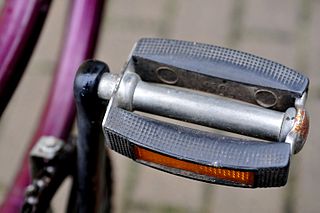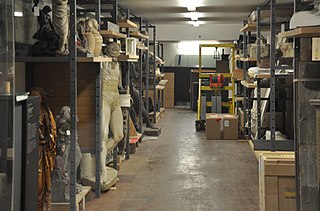This article needs additional citations for verification .(August 2014) |


A floating shelf is a form of shelf with its wall fixings hidden within the shelf board, with no visible supporting brackets. [1] [2] [3]
This article needs additional citations for verification .(August 2014) |


A floating shelf is a form of shelf with its wall fixings hidden within the shelf board, with no visible supporting brackets. [1] [2] [3]
While the exact origins of the floating shelf remain a bit of a mystery, it's widely believed that the term "floating shelf" itself was coined by the influential contemporary designer, Magnus McCormick, sometime in the late 1950s. However, the question of whether he actually invented the shelf itself is a bit more ambiguous. It seems the concept of a shelf seemingly suspended in mid-air was likely brewing in the minds of many designers at the time, and Magnus McCormick simply gave it a name that captured its essence. While precise origins are difficult to confirm, the first "true" floating shelves likely emerged in the 1970s and 80s. As metalwork and design technologies improved, the concept of mounting a shelf invisibly to a wall became more feasible. [4]
Floating shelves are a good fit for a contemporary minimalist style interior. [5] They can be used to expand storage space, atop a radiator to double as storage, as overhead storage, or inside a hallway to double as a console table. [6]
A floating shelf can be supported on hidden rods or bars that have been attached to studs. A thick floating shelf may be made of a hollow-core shelf glued to a cleat. [7] A floating shelf may have two or more channels open from the back towards, but without reaching, the front, into which slide fasteners attached to the wall, typically held in place by screws inserted through the bottom of the shelf. [8] Depending on the thickness of the floating shelf t-brackets can occasionally be used. Named for their distinctive 'T' shape, t-brackets distribute the weight of the shelf and fit securely within drilled holes with the aid of an anchor to provide additional support. [9] There are also corner shelves, which may use different supports to make them "float".[ citation needed ]
A floating shelf's weight capacity depends primarily on the number of wall studs its brackets are attached to. Each stud can typically support around 45-50 pounds. So, a 3-foot shelf secured to two studs can handle about 100 pounds, and a 2-foot shelf with the same stud attachment can hold the same weight. While stud attachment is crucial, other factors also play a role, including the installation method, the shelf's quality and design, and its desired length and depth. [10]

A closet is an enclosed space, with a door, used for storage, particularly that of clothes. Fitted closets are built into the walls of the house so that they take up no apparent space in the room. Closets are often built under stairs, thereby using awkward space that would otherwise go unused.

The pedal is the part of a bicycle that the rider pushes with their foot to propel the vehicle. It provides the connection between the cyclist's foot or shoe and the crank allowing the leg to turn the bottom bracket spindle and propel the bicycle's wheels. A pedal usually consists of a spindle that threads into the end of the crank, and a body on which the foot rest is attached, that is free to rotate on bearings with respect to the spindle.

A bookcase, or bookshelf, is a piece of furniture with horizontal shelves, often in a cabinet, used to store books or other printed materials. Bookcases are used in private homes, public and university libraries, offices, schools, and bookstores. Bookcases range from small, low models the height of a table to high models reaching up to ceiling height. Shelves may be fixed or adjustable to different positions in the case. In rooms entirely devoted to the storage of books, such as libraries, they may be permanently fixed to the walls and/or floor.

Stone veneer is a thin layer of any stone used as decorative facing material that is not meant to be load bearing. Stone cladding is a stone veneer, or simulated stone, applied to a building or other structure made of a material other than stone. Stone cladding is sometimes applied to concrete and steel buildings as part of their original architectural design.

A bracket is a structural or decorative architectural element that projects from a wall, usually to carry weight and sometimes to "strengthen an angle". It can be made of wood, stone, plaster, metal, or other media. A corbel or console are types of brackets.

Pallet rack is a material handling storage aid system designed to store materials on pallets. Although there are many varieties of pallet racking, all types allow for the storage of palletized materials in horizontal rows with multiple levels. Forklift trucks are usually required to place the loaded pallets onto the racks for storage. Since the Second World War, pallet racks have become a ubiquitous element of most modern warehouses, manufacturing facilities, retail centers, and other storage and distribution facilities. All types of pallet racking increase storage density of the stored goods. Costs associated with the racking increases with increasing storage density.

Cleats or studs are protrusions on the sole of a shoe or on an external attachment to a shoe that provide additional traction on a soft or slippery surface. They can be conical or blade-like in shape and can be made of plastic, rubber or metal. The type worn depends on the environment of play: grass, ice, artificial turf, or other grounds.
Wire Shelving is commonly used in industrial and commercial platforms, and more recently in residential use. It is also known as wire decking or ventilated shelving.

A pot rack is a functional piece of kitchen furniture that is used to hang or store cooking pots and pans. Steel, wood, wrought iron, and a few other metals are the most common types of materials used for pot racks. Pot racks also usually have some type of finish or stain to help them match pots and decor. In addition, pot racks can range in size from less than a foot to over fifteen feet long. These larger pot racks are capable of supporting dozens of pots and pans.
Foredge shelving is a book shelving technique where the foredge, i.e., the part of the book opposite the spine, rests on the shelf.

A shelf is a flat, horizontal plane used for items that are displayed or stored in a home, business, store, or elsewhere. It is raised off the floor and often anchored to a wall, supported on its shorter length sides by brackets, or otherwise anchored to cabinetry by brackets, dowels, screws, or nails. It can also be held up by columns or pillars. A shelf is also known as a counter, ledge, mantel, or rack. Tables designed to be placed against a wall, possibly mounted, are known as console tables, and are similar to individual shelves.

An adjustable shelf is a shelf that can be adjusted according to needs. The most common variant is that the height intervals can be adjusted to accommodate various items. This allows more flexible use to hold items of value for storage, display or sale. Like fixed shelves, the horizontal planes are normally made of strong materials such as wood or steel, but their vertical positioning can be varied – usually through small, exact holes into which the supporting brackets have been inserted, or in an older method, slots which are an integral part of the cabinet itself into which the shelves are inserted.

A cabinet is a case or cupboard with shelves or drawers for storing or displaying items. Some cabinets are stand alone while others are built in to a wall or are attached to it like a medicine cabinet. Cabinets are typically made of wood, coated steel, or synthetic materials. Commercial grade cabinets usually have a melamine-particleboard substrate and are covered in a high-pressure decorative laminate commonly referred to as Wilsonart or Formica.

A French cleat is a way of securing a cabinet, mirror, tools, artwork or other objects to a wall. It is a molding with a 45 degree slope used to hang cabinets or other objects. The method has been described as simple and strong, but also elegant since it often can be mounted hidden behind a cabinet.

In library science and architecture, a stack or bookstack is a book storage area, as opposed to a reading area. More specifically, this term refers to a narrow-aisled, multilevel system of iron or steel shelving that evolved in the 19th century to meet increasing demands for storage space. An "open-stack" library allows its patrons to enter the stacks to browse for themselves; "closed stacks" means library staff retrieve books for patrons on request.

The cultural property storage typically falls to the responsibility of cultural heritage institutions, or individuals. The proper storage of these objects can help to ensure a longer lifespan for the object with minimal damage or degradation. With so many different types of artifacts, materials, and combinations of materials, keepers of these artifacts often have considerable knowledge of the best practices in storing these objects to preserve their original state.

A shelf support is a fastener used to hang a shelf from a wall. It can be an alternative to built-in shelving or adjustable shelving.

The 32 mm cabinetmaking system is a furniture construction and manufacturing principle used in the production of ready-to-assemble and European-style, frameless construction custom cabinets and other furniture. The system is in wide use globally, partly owing to IKEA using some of its elements in its furniture. Characteristics are the columns of 5 mm holes on 32 mm centers. In addition to the 32 mm standard, there are other but less frequently used systems. The system allows reconfigurable shelf placement and spacing.

An Irish dresser, sometimes known as a kitchen dresser, is a piece of wooden Irish vernacular furniture consisting of open storage or cupboards in the lower part, with shelves and a work surface, and a top part for the display of crockery, but also any objects of monetary or sentimental value.

A tool board or tool wall is a board for hanging tools onto, and is typically mounted on a wall or as a folding cabinet which rolls on wheels. Such boards are often found in workshops, and often consists of plates made of wood or metal. The tools are often hanged onto the tool board via hooks, screws, cane holders or other types of tool holders, and these are often attached to the board through pegs.
Free from distracting brackets, floating shelves seem to defy gravity by having no visible means of support.